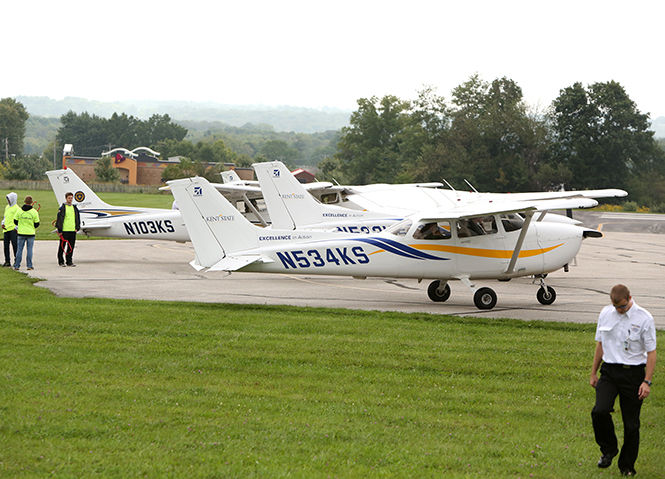CAEST seeks approval of first aerospace engineering major
The Kent State University fleet of cessnas prepares to take visitors to the Aviation Heritage festival at the Kent State Airfield on tours up into the sky on Sept 13, 2014.
February 22, 2015
Senior Brian Katona recently switched his major from aeronautical Systems engineering technology to mathematics. While interning at NASA, he found that his degree was not fully preparing him for his future career in aerospace engineering.
“I was doing an internship and realizing that my coursework wasn’t matching up with what the internship was asking me to do, so I had to find a way to kind of get the math background that I figured I would need on the job,” Katona said. “I had no computer programming experience and that was a necessary part of my internship, and then also, I didn’t really have any background in thermodynamics.”
Faculty Senate unanimously passed a motion to incorporate the Aerospace Engineering major within the Bachelor of Science degree at the Kent Campus on Feb. 9. However, the program will not be officially implemented until the Higher Learning Commission, Ohio Board of Regents and the Kent State Board of Trustees provides additional approval, said Maureen McFarland, senior academic program director of flight and air traffic control.
“While we were very happy to get the response and the support we’ve received so far, there’s still a lot more that needs to be done, quite a few wickets (requirements) that need to be met before we can start recruiting students into the program,” McFarland said.
Katona said that he would have enrolled in the aerospace engineering major had it been offered earlier. He said he feels the new degree will help engineering students gain more jobs in the aerospace industry.
The U.S. Bureau of Labor Statistics ranks Ohio as fifth among states with the highest levels of employment for aerospace engineers and 10th nationwide for the highest concentration of aerospace engineering jobs.
“The aerospace industry is the number one industry in the U.S. that has a trade surplus, which means we have money coming in versus coming out,” said Blake Stringer, assistant professor of aeronautics. “It’s about $61 billion a year that comes in, and every aircraft rolling off the line has pieces and parts that were made in Ohio.”
Northeast Ohio does not have a public university that offers an aerospace engineering program, despite the industry’s presence statewide, Stringer said. The Ohio State University and the University of Cincinnati are the only public universities that currently offer a degree in aerospace engineering in Ohio.
“As our college transitions to more of a research-based college, we’re going into aerospace engineering,” McFarland said. “This is kind of the next natural step for us, getting into more research opportunities and also just opportunities for students in northeast Ohio.”
The Aeronautics division of the College of Applied Engineering, Sustainability and Technology has also requested new lab equipment as part of the major’s proposal, which will be purchased upon approval.
McFarland hopes to have full approval for the major by the end of the summer or beginning of fall 2015 so that the college can begin recruiting students in spring 2016.
The aerospace engineering degree will focus on pure engineering, research and design, McFarland said. It will also consist of more high-level math and science courses than the aeronautical systems engineering technology degree.
Stringer, who is credited with building the majority of the new program’s curriculum, said the major would integrate 13 new aerospace engineering-specific courses and labs with some existing courses in CAEST. Two-to-three courses will be added per year to implement the program.
“Engineers, pure engineers, there’s a lot more math involved and a lot more theory behind things,” Stringer said. “Engineering technology, what we offer now, is a lot more applied, and it’s a lot more making do with current technology.”
The college is currently seeking accreditation of its aeronautical systems engineering technology program from the Accreditation Board for Engineering and Technology (ABET), an organization that monitors quality standards for academic programs in the areas of applied science, computing, engineering and engineering technology.
McFarland said the college also plans to pursue ABET Accreditation for its new aerospace engineering program.
Contact Victoria Manenti at [email protected].

























